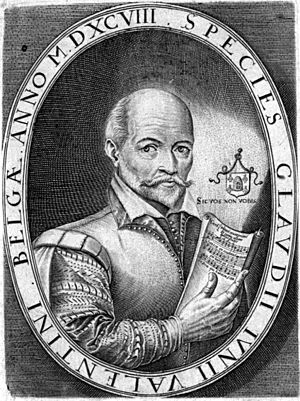Claude Le Jeune facts for kids
Claude Le Jeune (born around 1528 to 1530 – died September 26, 1600) was a famous composer from the late Renaissance period. He was from the Franco-Flemish region, which means he had roots in both France and Flanders (part of modern-day Belgium).
Claude Le Jeune was a key figure in a special music style called musique mesurée. He also wrote many "Parisian" chansons, which were popular songs in France during the late 1500s. His music was well-known across Europe, making him one of the most important composers of his time.
Contents
Life of Claude Le Jeune
Claude Le Jeune was born in Valenciennes, a city in France. He likely started his music training there. Early in his life, he became a Protestant.
His first known musical works, four chansons, were published in 1552. In 1564, he moved to Paris. There, he met many Huguenots, who were French Protestants. By this time, he was already gaining international fame. His name even appeared on a list of great composers.
Working with the Academie
In 1570, Le Jeune joined the Academie de musique et de poésie. This group was led by Jean-Antoine de Baïf. This partnership was very important for Le Jeune's music. Even though Baïf was a Catholic, they worked well together. Le Jeune continued to set Baïf's poems to music for many years.
In 1581, Le Jeune helped create music for a special wedding. This was for the Duke of Joyeuse and the queen's half-sister. He worked with other famous artists like Baïf and Ronsard.
Challenges and Escape
In 1589, Le Jeune faced danger because he was a Protestant. He had to escape Paris during a siege. Luckily, his friend, the composer Jacques Mauduit, helped him. Mauduit saved Le Jeune's life and prevented his music papers from being destroyed. Other Protestant composers were not as lucky. For example, Claude Goudimel was killed by a Catholic mob in 1572.
After escaping, Le Jeune moved to La Rochelle, a city where many Huguenots lived. But by the mid-1590s, he returned to Paris. His name appeared on lists of musicians for King Henry IV in 1596 and 1600.
Le Jeune composed a lot of music during his later years. Most of his works were published after he died. He passed away in Paris in 1600.
Claude Le Jeune's Music and Influence
Le Jeune was the most famous composer of secular (non-religious) music in France in the late 1500s. His favorite type of song was the chanson.
Musique Mesurée
After 1570, most of his chansons used ideas from musique mesurée. This was a musical style that matched the exact rhythm of French words. In musique mesurée, stressed syllables in the text would get longer notes. Unstressed syllables would get shorter notes. This made the music sound like it had quickly changing rhythms.
Le Jeune's "Parisian" chansons were often light and homophonic. This means all the voices sang the same rhythm together. They were sung a cappella, which means without instruments. His songs usually had three to seven voices, but sometimes up to eight.
His most famous secular work is Le printemps. It has thirty-three airs mesurés and six chansons. All of these were based on poems by Baïf.
Musical Innovations
Sometimes, Le Jeune used musical ideas that were considered "forbidden" by the rules of his time. For example, he used the "diminished fourth" interval. These rules were set by music theorists like Zarlino. Le Jeune knew these rules but sometimes broke them for expressive effect.
He was also interested in ancient Greek music theory. He used different musical genera in his music. These included the diatonic genus and the chromatic genus. His chansons using the chromatic genus were very chromatic. This means they used many notes outside the main scale.
Sacred Music
Le Jeune's most famous sacred (religious) work is his Dodécacorde. This collection has twelve psalm settings. He published it in 1598. Each psalm is set in a different mode, following Zarlino's ideas. Some of his psalm settings used many voices, like his Psalm 52, which had sixteen voices.
After his death, a collection of all 150 psalms, Les 150 pseaumes, was published. These were very popular and reprinted in many countries.
His last completed work was Octonaires de la vanité et inconstances du monde. It was published in 1606. This work had thirty-six songs based on poems by Antoine de Chandieu. It was for three or four voices. This was one of the last collections of chansons from the Renaissance. After this, the air de cour became the main type of secular song in France.
Le Jeune's Legacy
A lot of Le Jeune's music has survived. This includes 347 psalm settings, thirty-eight sacred chansons, eleven motets, and a mass setting. His secular works include 146 airs and sixty-six chansons. He also wrote forty-three Italian madrigals. Some instrumental pieces for lute were also published after he died. He was lucky that his many music papers were published. His friend, Jacques Mauduit, was not as fortunate, and most of his music was lost.
Some critics of his time said Le Jeune broke rules for good music writing. For example, he sometimes used the interval of a major sixth. He also often had voices crossing each other. These techniques later became common in the Baroque music style. This shows that Le Jeune's music was ahead of its time.
Images for kids
See also
 In Spanish: Claude Le Jeune para niños
In Spanish: Claude Le Jeune para niños



